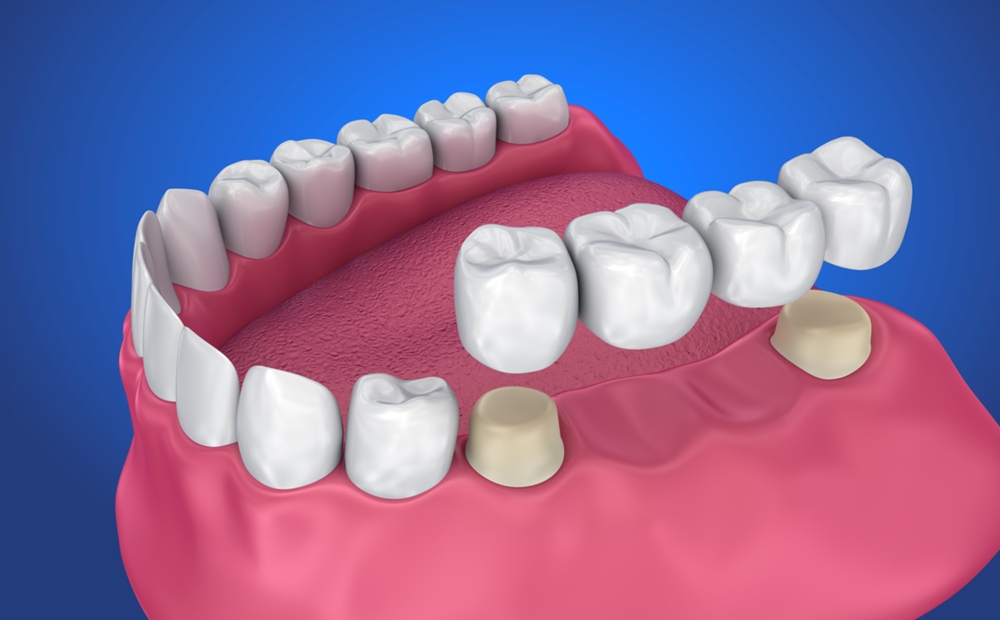Dental bridges are prosthetic appliances used to fill tooth gaps. They use dental implants or nearby natural teeth as anchors for prosthetic teeth (pontics) to “bridge” the space left by one or more missing teeth.
Dental bridges come in a variety of styles, such as cantilever bridges, conventional bridges, and implant-supported bridges.
- Traditional bridges: For these bridges, the neighbouring teeth on each side of the gap are used as anchors to hold the pontics in place.
- Cantilever bridges: Bridges that only rely on the teeth on one side of the gap for support are known as cantilever bridges.
- Implant-supported bridges: These bridges are held up by dental implants that have been surgically inserted into the jawbone. The implants act as false tooth roots to firmly anchor the bridge.
Benefits of Using Dental Bridges
People with missing teeth might benefit from dental bridges in a number of ways. Here are a few significant advantages:
- Function Restored: Dental bridges give you back your ability to chew and bite properly, enabling you to eat a larger variety of foods and keep a healthy diet.
- Better Speech: Speech clarity might be hampered by tooth gaps. Dental bridges fill in such spaces, which helps with pronunciation and communication.
- Improved Appearance: Bridges are crafted to appear natural and blend in with your existing teeth, improving the look of your smile as a whole.
- Preventing Tooth Shifting: When a tooth is missing, the surrounding teeth may progressively reposition themselves to fill the void, leading to biting issues and misalignment. By bridging the gap and preventing movement, dental bridges assist in maintaining good tooth alignment.
- Preservation of Facial Structure: Bone loss in the jaw caused by missing teeth can change the form and structure of your face. Dental bridges support the underlying jawbone, preserving the natural curves of the face.
- Convenient and Non-Removable: Bridges are set in place and do not need to be removed for cleaning or maintenance, in contrast to removable dental items like dentures. This provides comfort and a feeling of security.
- Longevity: Dental bridges can survive for many years with good maintenance and routine dental exams, offering a strong and long-lasting tooth replacement alternative.
Since every patient’s situation is different and necessitates a customized treatment plan, it’s crucial to speak with a dentist in Dearborn to find out if dental bridges are the best course of action for you.
Procedure for Getting Dental Bridges
The stages involved in getting dental bridges near you are as follows:
- Consultation: Discuss the pros and cons of dental bridges with your dentist in order to establish whether they are right for you.
- Treatment Planning: Establish a specialized treatment strategy, taking the kind of bridge and any required pre-treatment measures into account.
- Teeth Preparation: To make room for dental crowns, a little amount of enamel is removed from the neighbouring teeth.
- Impressions: To make a bespoke bridge, impressions of your teeth and the gap are obtained.
- Bridge Installation: Dental cement is used to attach the permanent bridge to the prepared teeth.
- Follow-Up: Plan follow-up appointments to check for appropriate healing and make any required modifications.
- Oral Care: Maintaining proper dental hygiene and going in for frequent checkups at a dentist near you will extend the life of the bridge
Dental Bridges at Royal Dentistry
Considering getting dental bridges in Dearborn? Come see our skilled and experienced dental team! We prioritize your comfort and will ensure that your visit to our clinic is comfortable and smooth as possible.
We use the latest technology and equipment to give you the best treatment possible. Schedule a consultation with us today!

